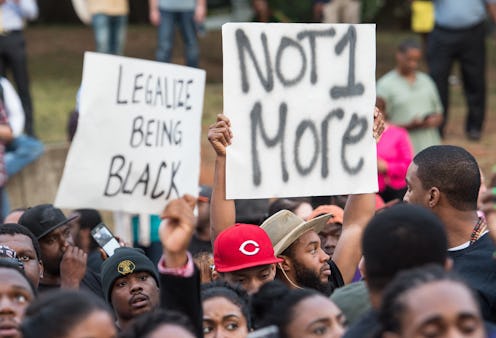On Tuesday in El Cajon, California, police shot Alfred Olango, a black man witnesses allege was unarmed and mentally disabled. San Diego radio and TV station KPBS reported that during a news conference, El Cajon chief of police Jeff Davis confirmed that Olango was indeed unarmed and that he had died in the hospital after being both shot and tased. Witness and El Cajon police accounts of what happened leading up to the fatal shooting, however, differ significantly.
According to the El Cajon police department, police arrived on the scene after a call that the 30-year-old man was "not acting like himself." Moments after they arrived, one policeman tased Olango. A second officer shot the man at the same time. Davis described the situation during a news conference later on Tuesday:
The subject paced back and forth while officers tried to talk to him. At one point, the subject rapidly drew an object from his front pants pocket, placed both hands together and extended them rapidly toward the officer taking up what appeared to be a shooting stance.
Though no weapon was found after Olango was taken to the hospital, the police department has not disclosed what the "object" Olango allegedly pointed at the police was. The department is asking witnesses to share footage with them, as an investigation is underway.
NBC 7 San Diego interviewed witnesses, some of whom claimed that Olango was cooperating and did have his hands in the air, contrary to the police department's claims in the press release. One witness interviewed, who identified himself as George, alleged that five shots total were fired:
I didn't hear any command "Halt," "Stop," or "I'll shoot," I didn't hear any command or yelling. I didn't hear the man say anything. Next thing I see "Pow, pow, pow, pow, pow" — five shots.
The call that prompted police to arrive on the scene was dialed in by Olango's sister. In a Facebook livestream of the moments following the fatal shooting, she can be heard crying, saying that she should have called crisis communications instead of the police. According to NBC 7, she said:
He's sick, he needs help ... I called you to help me but you killed my brother. Why couldn't you guys tase him? Why, why, why, why?
You can watch the video here. Rob Ransweiler, the police department's spokesman, expressed that although there are varying witness reports as to whether or not Olango's hands were up in the air, he believes that "the community will support the decision made by the officer." However, many community members have expressed they feel otherwise, as have begun to gather around where Olango was shot in protest.
